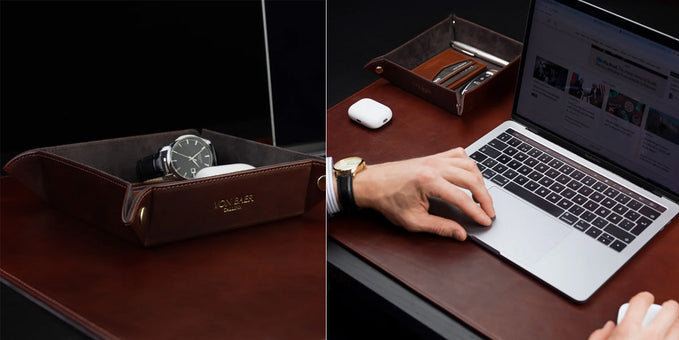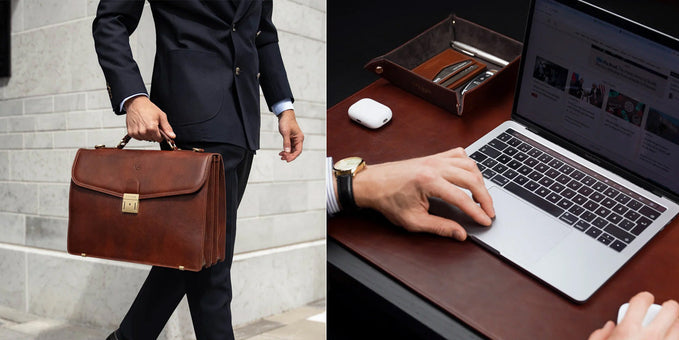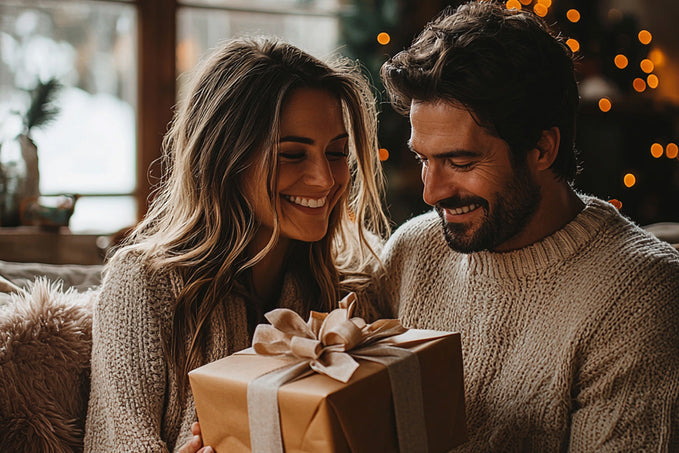Is Leather Really That Waterproof?

Love leather products like bags, sofas, and shoes?
Then you’d better learn the difference between leathers that are actually waterproof and those that are completely unsuitable for wet conditions.
In this article, we’ll be highlighting everything you need to know about different types of leather and how good each type is at repelling liquids.
Take a look through these pointers to find out which leathers are the most waterproof and which ones aren't.
Before we get into it, let’s start with:
The difference between waterproof and water resistant
Many people will use these phrases interchangeably to describe items with any kind of waterproofing ability.
The truth is, these terms both mean very different things.
Water resistant items are not waterproof. If your bag is water resistant, it’s surface will have a degree of water repellent capability, but it won't necessarily be waterproof.
You should only call a surface or container waterproof if it’s completely impenetrable under any level of water coverage.
Water resistant items are suitable for light sprinkles of water, light rain showers, and moist weather conditions. Waterproof items should be able to protect their interior capacity if they are completely submerged in water.
Raw leather doesn't actually mix well with water. The material possesses a certain level of natural water resistance, but when it gets soaked, the impact is quite destructive.
Raw leather is permeable, so it absorbs moisture. As the material dries, it will stiffen and its luscious soft surface can be utterly ruined. If the leather doesn't dry fast enough and the water remains adsorbed, it’ll likely start to fester growing levels of bacteria which then leads to rot.
The leather is treated in various ways to give it varying levels of water resistance. As a natural and permeable material, leather can never actually be made 100% waterproof.
Generally speaking, age determines how effective a leather surface will perform at repelling liquids. Just like wood or any other permeable material, the more the surface is protected with quality waterproofing agents, the more effective it’ll be at preventing water penetration.

The treatments and sprays available
All genuine leather needs to be protected. There is a range of treatments out there that can help make leather water resistant. One of the most common ways to keep leather protected from moisture is by applying wax such as Dubbin or Nikwax.
Waxing is popular because it’s easy and can work well for almost any type of leather. Waxing and “conditioning” as explained in more detail below, are only suitable for certain types of leather.
Wax will ruin suede. To protect suede, you’ll need to use a special spray that creates an invisible layer that is both water-resistant and oil-repellent. Wax is best for leathers with a completely smooth surface free from any fibres.

Here’s a quick walkthrough on how waxing works:
How to apply wax to leather
1. First, you have to make sure the surface of the leather is completely clean. Any hard stains or dirt marks will stop the wax from getting into the leather so they must be removed as effectively as possible.
2. Next, you need to apply a small amount of wax at a time. It’s best to apply the wax to the cloth first. Never drop a dollop onto the leather directly. The wax works best when it’s spread as evenly as possible, so if you think it’s too stiff when you first open it up, you can warm some up with a torch or hair dryer. Do this slowly to avoid damaging the wax with too much heat.
3. Once you’ve added an evenly spread layer of wax, you need to let it dry naturally. This should take around an hour or slightly less. You need to place the leather item in a cool and ventilated space. Don't try and speed up the drying process with heat or direct sun as this can cause damage to the colour or deform the surface of the leather.
4.When the leather is perfectly dry, you should buff off excess wax with a dry cloth. This should leave a nice protective sheen on the surface of your leather that repels water, oil, and even dust.
Waxing is great because it’s simple and easy to apply. It adds a layer of protection to the exterior surface of your leather, but “conditioning” the fabric itself is also very important. Leather conditioning helps keep your leather supple. Afraid your leather is cracking or getting too hard? Then applying wax alone won't be enough, it’s time to do some conditioning.
How to condition leather
Like waxing, conditioning is also very simple to apply yourself. It’ll restore your leather back to how it was when you first bought it while also improving its water-resistant qualities. It’s not usually a good idea to over-condition leather. In most cases, leather is used for its strength, especially in supporting the structure of shoes and bags. The more you condition it, the softer it goes. You don't want items like these losing all of their strength and shape, so don't over-do it
Here’s a step by step guide on conditioning leather:
1. Unlike waxing, conditioning requires the leather to be wet. As the water evapourates off the surface of the leather, the material will be able to absorb more of the conditioning treatment. You don't need to submerge the leather, but you should ensure it is damp before applying the conditioner.
2. You can use a small cloth or your fingertips to rub the conditioner into the leather. You need to make sure the conditioner is rubbed into every part of the leather, so get your fingers involved when it comes to addressing areas that are hard to reach.
3. Remove any excess conditioner before allowing the leather to dry naturally at room temperature.
Different leathers have different levels of water resistance
Let’s go over some of the most common types of leather and explain the level of water resistance that each type tends to have.
Faux leather
A lot of people tend to believe that faux leather holds many of the same properties as real leather when it comes to waterproofing. In truth, the materials are very different. One of the most common ways that genuine leather is made waterproof, is to apply a plastic based layer of protection to the surface of the leather that makes it completely water repellent. Faux leather is already made from plastic. This makes its actual structure waterproof without any need for further protection.
Synthetic leather
This type of leather is usually thinner and of much lower quality than genuine leather. It’s not made from plastic, so like real leather, synthetic leather absorbs moisture. It needs to be treated with a protective spray to make it water resistant.
Nubuck leather
Nubuck leather is a version of full grain leather that has been buffed down. The surface becomes a very fine, but durable type of Suede. Nubuck naturally holds some degree of water resistance to small amounts of water, but it requires further waterproofing from a special spray to make it practical for everyday outdoor use.
Suede leather
Suede is one of the most sensitive leathers out there. Why? Because it’s not made from the hard-wearing exterior used for typical leather. Instead, Suede is made from the underside of the skin. It’s then rubbed to soften the fibres on its surface which gives it the velvet-like feel we all expect.
Suede comes from the same animal as other leathers, but it doesn’t offer the same level of durability. Suede is much easier to stain and scratch than normal leather and will discolour if left in direct sunlight for too long. It mustn't be stored in areas that could become humid like bathrooms or kitchens because the moisture in the air will wreak havoc on its soft surface.
Full and top grain leather
Full grain and top grain leathers are the most durable and water resistant types of leather available because they’re taken from the toughest parts of the animal hide. This leather is not totally waterproof in its raw form. It still needs to be waxed or sprayed with treatment in order to make it as waterproof as possible.
Most top quality items that need to be strong or are used for outdoor surfaces will be made from full grain or top grain leather.
We only use full grain leather for our briefcases (shop them here).
Conclusion
That’s it! These are the key things you need to know about waterproofing your leather items.
Remember, it’s always a good idea to patch test a particular product before going ahead with full coverage. In a lot of cases, wax, sprays and conditioners will have a bit of an impact on the colour of leather.
Always try these agents on a small hidden area first to make sure you’re happy with the results.
You can shop all Von Baer products here.

Author: Albert Varkki
Albert Varkki is the co-founder of Von Baer. He understands leather products as a consumer, supplier, and a manufacturer, helping you with the inside knowledge you need, to choose the perfect leather product for you.
We strive for the highest editorial standards, and to only publish accurate information on our website.
Leave a Comment
Your email address will not be published.






